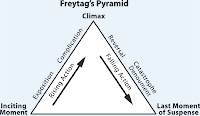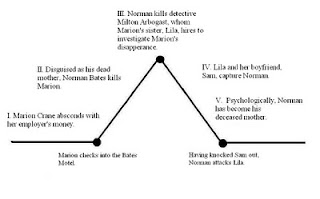Aristotle's Unities:
Narrative should:
- Take place in same location
- Be in real time
- Have all action moving towards a logical conclusion
Freytag's Dramatic Structure:
Narrative should be divided into 5 parts:
- Exposition - setting and characters set
- Rising Action- string of event begins to start main conflict and starts building an exciting story
- Climax- moment of greatest tension, uncertainity and audience involvement
- Falling Action and Resolution- all action that happens after the climax and is usually solved by the end
Levi-Strauss's Binary opposition:
Narrative should:
Syd Field's Three Act Plot Structure:
Believed that a typical film could be separated into three different acts:
Barthes' Enigma Code:
Roland Barthes believed that their are narrative codes that occur in every film, they are:
Todorov's theory:
Todorov said that their are five stages within a conventional narrative. These are:
Vladimir Propp
Vladidmirr said that in conventional narratives, their are five significant characters that are always present, these being:
Taken
Hero - The dad Bryan: he finds the girls
Villain - Peter (the man who meets the girls at the airport): he is the person who gets the girls abducted
Donor- Stepfather Stuart: pays for Bryan's expenses
Sidekick - Bryan's friend Sam: gives information on the situation
Heroine - his daughter Kim
Narrative should:
- Be based on opposition or conflict- have two opposite sides and characters. May often function on an ideological level for example; cowboys versus indians.
Examples of films with clear binary oppositions; Star Wars, Lord of the Rings etc.
Syd Field's Three Act Plot Structure:
Believed that a typical film could be separated into three different acts:
- First Act: Gives a sense of what the film is going to be about, who the main character is and what the audience can expect in terms of genre
- Second Act: This is the longest part of the film and shows the main character in a number of problems/situations normally independently
- Third Act: The hero will finally take control of their problems (usually through confrontation) and will achieve a final victory
Barthes' Enigma Code:
Roland Barthes believed that their are narrative codes that occur in every film, they are:
- The enigma code
- Symbols and signs
- Points of cultural references
- Simple description/reproduction
Todorov's theory:
Todorov said that their are five stages within a conventional narrative. These are:
- Equilibrium: all is as it should be
- Disruption: some sort of disruption occurs
- Recognition: it is recognised that this disruption has occured
- Repair (attempt): an attempt is made to fix this disruption
- Re-instatement of equilibrium

Vladimir Propp
Vladidmirr said that in conventional narratives, their are five significant characters that are always present, these being:
- Hero: usually male and is the person who restores the narrative equilibrium
- Heroine: usually the character most threatened by the villain and needs to be 'saved'
- Villain: creates the narrative disruption
- Mentor/Donor: gives the hero something such as advice or an object which helps in the resolution of the narrative
- Sidekick: aids the hero in the task of restoring equilibrium
Taken
Hero - The dad Bryan: he finds the girls
Villain - Peter (the man who meets the girls at the airport): he is the person who gets the girls abducted
Donor- Stepfather Stuart: pays for Bryan's expenses
Sidekick - Bryan's friend Sam: gives information on the situation
Heroine - his daughter Kim





No comments:
Post a Comment